New South Wales C38 class locomotive
The C38 class (occasionally known as the 38 class and nicknamed "Pacifics" by some railwaymen) was a class of steam locomotive built for the New South Wales Government Railways in Australia.
| New South Wales C38 Class | |||||||||||||||||||||||||||||||||||||||||
|---|---|---|---|---|---|---|---|---|---|---|---|---|---|---|---|---|---|---|---|---|---|---|---|---|---|---|---|---|---|---|---|---|---|---|---|---|---|---|---|---|---|
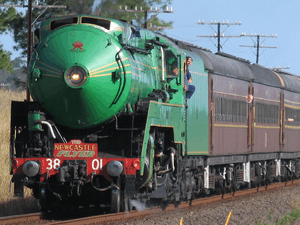 3801 on a Newcastle Flyer charter in October 2005 | |||||||||||||||||||||||||||||||||||||||||
| |||||||||||||||||||||||||||||||||||||||||
| |||||||||||||||||||||||||||||||||||||||||
| |||||||||||||||||||||||||||||||||||||||||
| |||||||||||||||||||||||||||||||||||||||||
Constructed between January 1943 and November 1949, the 30 locomotives in the class were designed to haul express passenger services throughout New South Wales. They were the only New South Wales locomotives to use the popular Pacific 4-6-2 wheel arrangement and were the last steam locomotives in the state to be built for passenger train operation, all subsequent deliveries being specifically for freight haulage.[1]
Design
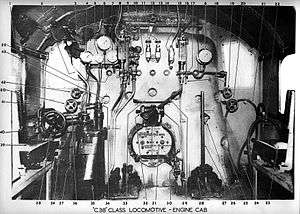
The 38 class were first conceived in the 1930s when the NSWGR established there was a need for a locomotive to eliminate the complications of double heading on a number of fast intrastate passenger trains.[2]
The design was influenced by the fashion for streamlining at the time, including elements of the class J locomotives of the Norfolk and Western Railway in the United States. The design team was headed by Harold Young, the Principal Design Engineer (later Chief Mechanical Engineer) of the NSWGR.[3] The conditions of trackwork with frequent sharp curvature to be traversed at high speed would require six-coupled driving wheels in a 'Pacific' 4-6-2 configuration. Maintenance requirements suggested a two-cylinder simple steam locomotive.
The design was carried out by the NSWGR Locomotive Section of the Design Office and incorporated the latest developments in locomotive design from Australia and overseas. The incorporation of as many Australian manufactured components as possible was a requirement at the design stage.[3]
Similarly to the earlier D57 class (which had some input from Young) the massively proportioned locomotive incorporated a cast steel chassis. The design also sported cast Boxpok coupled wheels for better rotational balance, and a Delta trailing truck.[3]
History
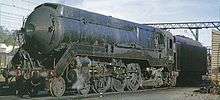
.jpg)
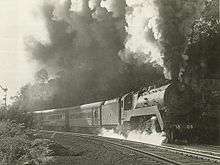
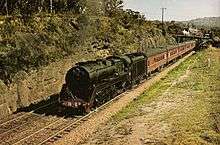
In May 1939 an order for five 38 class locomotives was placed with Clyde Engineering.[4] They suffered many delays during construction, mostly due to resource shortages caused by World War II and the Great Depression. The first five locomotives were built by Clyde Engineering and had distinctive semi-streamlined boiler casing. The locomotive, however, as with many others, did possess a teething trouble: no fireman could maintain steam in her 245 psi boiler. Early trials on the Southern line saw 3801, the class leader, appointed 2 firemen, and the now-late travelling inspector Jack Bowen recalled that "some gun passenger firemen brought in from Eveleigh (near the Sydney CBD) in February 1943 even tried using long-handle shovels." Mr Bowen also recalled that the problem was solved when an imported Bathurst fireman insisted on inspecting the loco's blast pipe. He demonstrated how the blast pipe's shape made it impossible for steam to cleanly clear the chimney's apron, which affected the smokebox's vacuum action on the fire grate, making her more demanding to fire. After the blast pipe was adjusted, 3801 erupted as a good engine should.[3]
As the last of the 5 initial locomotives were leaving the shop in 1945, a decision was made to purchase more. This order of 25 locomotives were built at the New South Wales Government Railways' Eveleigh Railway Workshops (13 even number locomotives) and Cardiff Locomotive Workshops (12 odd numbered locomotives). These locomotives were non-streamlined to improve maintenance.[3][5][6]
The Clyde Engineering built examples were delivered in wartime grey. Following the cessation of the war, all were repainted green as were the 25 unstreamlined locomotives from new. All except 3813 were repainted black in the 1950s. 3801 and 3830 had their green livery restored due to pressure from heritage groups in the 1960s.[5][7]
Among the services they initially hauled were the Central West Express, Newcastle Flyer, Melbourne Limited Express, Riverina Express and South Coast Daylight Express as well as the overnight mail trains. Because of their axle load they were confined to operating between Sydney and the following extremities of operation: Port Kembla (Coniston), Albury, Dubbo and Maitland, although they worked the North Coast passenger trains to Brisbane until track problems surfaced.[6]
Following the arrival of the 42, 43 and 44 class diesel locomotives in the 1950s, these began to take over some express services, but the 38 class continued to haul many passenger and freight trains. Even after the electrification of the Main Western line to Lithgow in 1957 and the Main North line to Gosford in January 1960, using 46 class electric locomotives, the 38s still operated the Central West Express between Lithgow and Orange into the 1960s and the Newcastle Flyer between Gosford and Newcastle until December 1970.[8]
The 38 class briefly returned to the former Melbourne Limited Express route in April 1962, when 3830 and 3813 hauled the inaugural standard gauge Spirit of Progress from Albury to Sydney. The first 38 class locomotive was withdrawn in 1961 with the last withdrawn in December 1970.[5][7]
In August 1970, 3801 hauled the Western Endeavour to Perth following the completion of the standard gauge Trans-Australian Railway with 3813 assisting as far as Port Pirie. In April 1988, 3801 again operated to Perth during the Australian Bicentenary.[6][9]
3801 featured in the 1974 short film A Steam Train Passes.
Roster
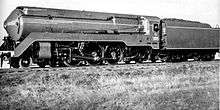
| Streamlined | ||||||||
|---|---|---|---|---|---|---|---|---|
| Locomotive | Builder | Builder's No | Built | In Service | Withdrawn | |||
| 3801 | Clyde Engineering | 463 | Dec 1942 | 22 Jan 1943 | 19 Oct 1965 | |||
| 3802 | Clyde Engineering | 464 | Mar 1943 | 8 Apr 1943 | 31 Jan 1967 | |||
| 3803 | Clyde Engineering | 465 | Aug 1943 | 9 Sep 1943 | 29 Feb 1968 | |||
| 3804 | Clyde Engineering | 466 | Jan 1944 | 10 Feb 1944 | 29 Oct 1965 | |||
| 3805 | Clyde Engineering | 467 | Feb 1945 | 2 Mar 1945 | Dec 1961 | |||
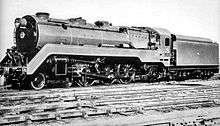
_2005.jpg)
| Non streamlined | ||||||||
|---|---|---|---|---|---|---|---|---|
| Locomotive | Builder | Builder's No | Built | Withdrawn | ||||
| 3806 | Eveleigh Railway Workshops | 158 | 1945 | 1967 | ||||
| 3807 | Cardiff Locomotive Workshops | 159 | 1946 | 28 Sep 1968 | ||||
| 3808 | Eveleigh Railway Workshops | 160 | 1946 | 1968 | ||||
| 3809 | Cardiff Locomotive Workshops | 161 | 1946 | 1969 | ||||
| 3810 | Eveleigh Railway Workshops | 162 | 1946 | 1969 | ||||
| 3811 | Cardiff Locomotive Workshops | 163 | 1946 | 1969 | ||||
| 3812 | Eveleigh Railway Workshops | 164 | 1946 | 1965 | ||||
| 3813 | Cardiff Locomotive Workshops | 165 | 1946 | 12 Sep 1970 | ||||
| 3814 | Eveleigh Railway Workshops | 166 | 1946 | 1966 | ||||
| 3815 | Cardiff Locomotive Workshops | 167 | 1947 | 1967 | ||||
| 3816 | Eveleigh Railway Workshops | 168 | 1947 | 1966 | ||||
| 3817 | Cardiff Locomotive Workshops | 169 | 1947 | 1963 | ||||
| 3818 | Eveleigh Railway Workshops | 170 | 1947 | 1968 | ||||
| 3819 | Cardiff Locomotive Workshops | 171 | 1947 | 1963 | ||||
| 3820 | Eveleigh Railway Workshops | 172 | 1947 | 29 Dec 1970 | ||||
| 3821 | Cardiff Locomotive Workshops | 173 | 1948 | 1962 | ||||
| 3822 | Eveleigh Railway Workshops | 174 | 1947 | 1970 | ||||
| 3823 | Cardiff Locomotive Workshops | 175 | 1948 | 1967 | ||||
| 3824 | Eveleigh Railway Workshops | 176 | 1948 | 1969 | ||||
| 3825 | Cardiff Locomotive Workshops | 177 | 1948 | 1969 | ||||
| 3826 | Eveleigh Railway Workshops | 178 | 1948 | 1961 | ||||
| 3827 | Cardiff Locomotive Workshops | 179 | 1948 | 1970 | ||||
| 3828 | Eveleigh Railway Workshops | 180 | 1949 | 1969 | ||||
| 3829 | Cardiff Locomotive Workshops | 181 | 1949 | 1966 | ||||
| 3830 | Eveleigh Railway Workshops | 182 | 1949 | 1967 | ||||
Preservation
4 of the 38 class locomotives survive-3801, 3813, 3820 and 3830. 3813 is in pieces at Dorrigo after an overhaul in 1972 by the former NSW Rail Transport Museum was forced to be stopped by the then commissioner of the Public Transport Commission, Philip Shirley who ordered that the locomotive's parts be transferred to the scrapyard. The NSWRTM managed a reprive and the parts were sent to be stored in many locations. Components such as the wheels, cab and smokebox were stored in S trucks at Thirlmere, the frame and tender at Clyde and the boiler at Castle Hill until they were donated to the Dorrigo Steam Railway & Museum. Over time all were donated to the Dorrigo museum and put in storage there [10]
| Preserved C38 Class Locomotives | ||||||||
|---|---|---|---|---|---|---|---|---|
| No. | Description | Manufacturer | Year | Organisation | Location | Status | Ref | |
| 3801 | 4-6-2 express passenger | Clyde Engineering | 1943 | Transport Heritage NSW | Thirlmere | Operational (Awaiting relaunch) | NSW Heritage Register Locomotive, Steam 3801 | |
| 3813 | 4-6-2 express passenger | Cardiff Locomotive Workshops | 1946 | Dorrigo Steam Railway & Museum | Dorrigo | Dismantled | ||
| 3820 | 4-6-2 express passenger | Eveleigh Railway Workshops | 1947 | Transport Heritage NSW | Thirlmere | static exhibit | NSW Heritage Register Locomotive, Steam 3820 | |
| 3830 | 4-6-2 express passenger | Eveleigh Railway Workshops | 1949 | Powerhouse Museum | Thirlmere | awaiting completion of overhaul | Powerhouse Museum Locomotive 3830 | |
References
- "Some Notes on the C38 Class 4-6-2 Locomotive" Young, Harold Australian Railway Historical Society Bulletin December 2003 pp443-463
- The C38 Class, John. B. Thompson pp3 'Why the 38's'
- Leon., Oberg (2010). Locomotives of Australia 1850s-2010 (5th ed.). Kenthurst, N.S.W.: Rosenberg Publishing Pty ltd. ISBN 9781921719011. OCLC 631100395.
- "The 38 Class Part 3" Roundhouse July 1981 page 22
- Flyer. Sydney: New South Wales Rail Transport Museum. 1970. pp. 35–40. ISBN 0-909862-16-8.
- Grunbach, Alex (1989). A Compendium of New South Wales Steam Locomotives. Sydney: Australian Railway Historical Society, NSW Division. pp. 210–229. ISBN 0-909650-27-6.
- Oberg, Leon (1984). Locomotives of Australia 1850's - 1980s. Frenchs Forest: Reed Books. pp. 168–170. ISBN 0-730100-05-7.
- Preston, Ron G (1992). 3801 A Legend in Steam. 3801 Limited. ISBN 0-646-11931-1.
- "3801 West" Railway Digest July 1988 page 250
- http://www.australiansteam.com/3813.htm
External links
![]()